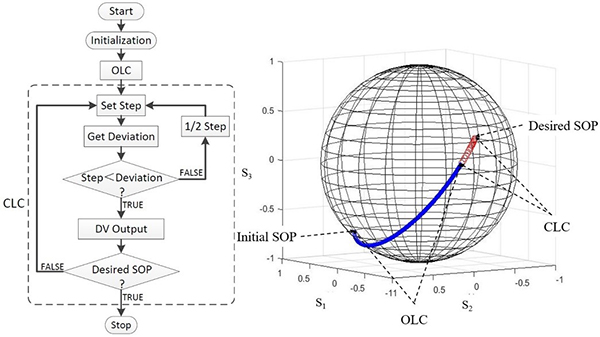Polarization-induced penalties such as polarization mode dispersion (PMD) and polarization dependent loss/gain (PDL/PDG), are crucial obstacles to fully realize the ultrahigh speed long-haul fiber-optic network, as well as guarantee the reliability of quantum keys distributing in optical-fiber-based quantum communication system. To mitigate those penalties, the state of polarization (SOP) must be controlled effectively. Up to now, there are many approaches to manipulate the SOP such as fiber bending or squeezing, Faraday rotation, fiber nonlinear effect, magnetic field modulated D-shaped fiber, and electro-optic effect in LiNbO3 waveguide. Among them, the piezoelectric polarization controllers (PPCs) based on fiber squeezing, are more practical and widely used because of their low power penalty, which are particularly suitable for optical fiber backbone system.
On the other hand, the control algorithm is rather important for developing high-speed PPCs. At present, most algorithms are basically kinds of closed-loop feedback methods, such as simulated annealing (SA) and genetic algorithm (GA), which usually manipulate the SOP blindly, and get the desired SOP by repeated attempts, resulting in very low and nonuniform control speed. Therefore, to develop the high-speed and accurate polarization controller is still a challenging work.
Recently, Dr. Bochen Wang and Prof. Zhengyong Li in Beijing Jiaotong University propose and demonstrate a novel scheme of the semi-open-loop polarization control (SOL-PC). The relevant research results have been published in Chinese Optics Letters, Vol. 18, Issue 5, 2020 (Wang Bochen, Li Zhengyong. Uniformly high-speed semi-open loop polarization control and PMD suppression [J]. Chinese Optics Letters, 2020, 18(5): 050601).
The fundamental theory is the matric model propose by them early: To get any desired SOP by the SOL-PC, the initial SOP is firstly processed by the open-loop control (OLC) based on the matrix model of a three-unit PPC, and jumps quickly to approximate the desired one. Then it will be finely adjusted by the variable-step close-loop control (CLC) to further reduce the error and be locked precisely at the desired SOP. The response time is three-order faster than that of the present CLC, while the control speed is uniform for any SOPs and the average deviation is on a par with the CLC.
"Due to its predominant advantages, the SOL-PC scheme is promising to stimulate the research and development of the polarization control to give birth to a perfect product, meeting the future requirements." says Prof. Zhengyong Li.
This work proposed a new scheme of the SOL-PC for accurate polarization control with uniform high speed. And it has been used to suppress the PMD effect, and successfully reduce the first-order PMD to almost zero. In the future, the scheme will be applied to enhance the reliability of the optical-fiber based quantum key distribution. In addition, the SOL-PC scheme can also be employed to adjust the polarization of spatial light with fast uniform speed.

Flow chart of the SOL-PC scheme (left), evolution of the SOP on the Poincaré sphere when perform the SOL-PC (right) for a control unit.


